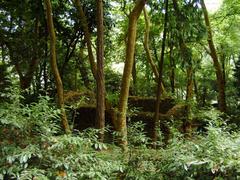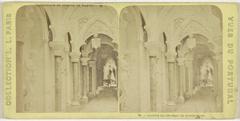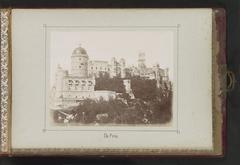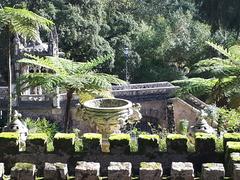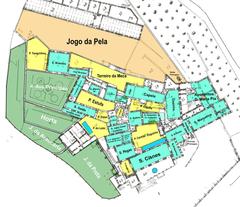Sintra Marmoris Palace: Visiting Hours, Tickets, and Complete Guide to Sintra Historical Sites
Date: 03/07/2025
Introduction
Sintra Marmoris Palace, also known as the Sintra National Palace or Palácio da Vila, is one of Portugal’s most captivating architectural and historical treasures. Situated in the heart of Sintra—a UNESCO World Heritage site—the palace boasts a unique blend of medieval, Gothic, Manueline, Renaissance, and Romantic styles. Its iconic twin conical chimneys, striking azulejo tilework, and centuries-old royal legacy make it a must-visit destination for travelers, history buffs, and architecture enthusiasts alike (Sintra Portugal Tourism; Wikipedia).
This guide provides detailed information on Sintra Marmoris Palace’s history, architectural highlights, visiting hours, ticketing, accessibility, tips for visitors, and recommendations for exploring Sintra’s surrounding historical sites.
Table of Contents
- Historical Overview and Significance
- Architectural Highlights and Notable Rooms
- Visitor Information
- Nearby Attractions
- Special Events and Guided Tours
- Travel Tips and Seasonal Advice
- FAQs
- Visual Highlights
- Related Articles
- Conclusion and Call to Action
- References
Historical Overview and Significance
Sintra Marmoris Palace’s origins date back to the Moorish era, when a residence was established for local governors. After the Christian Reconquista in 1147, Portuguese royalty adopted and expanded the palace, particularly under King Dinis I and later King João I, who initiated extensive remodeling that shaped the palace’s core structure. King Manuel I’s early 16th-century enhancements introduced Manueline windows and ornate tilework, reflecting Portugal’s Age of Discovery (Sintra Explorers; Mad About Sintra).
The palace remained a favored royal retreat and was continuously used until the end of the monarchy in 1910. Its unique architectural fusion and historical resonance led to its designation as a National Monument in 1910 and its inclusion in the UNESCO World Heritage cultural landscape of Sintra in 1995 (Sintra Portugal Tourism; Wikipedia).
Architectural Highlights and Notable Rooms
Sintra Marmoris Palace is celebrated for its harmonious blend of architectural styles and rich decorative arts. Among its most notable features and rooms:
- Twin Conical Chimneys: Standing 33 meters high, these chimneys dominate Sintra’s skyline and are a symbol of the palace (Sintra Portugal Tourism).
- Swans Hall (Sala dos Cisnes): Adorned with a ceiling of painted swans, symbolizing royal alliances and artistry.
- Coat-of-Arms Room (Sala dos Brasões): Topped with a domed ceiling featuring the coats of arms of 72 noble Portuguese families.
- Magpies Room (Sala das Pegas): Notable for its unique ceiling displaying 136 magpies, a whimsical nod to courtly intrigue.
- Arab Room: Decorated with 15th-century tiles and a central fountain, reflecting Moorish influence.
- Grotto of the Baths: A rococo addition featuring intricate tilework and stucco representing mythological and seasonal themes.
- Royal Chapel: The oldest surviving part of the palace, with striking tile floors and painted walls depicting the Holy Spirit (Sintra Portugal Tourism).
Visitor Information
Visiting Hours
-
Sintra National Palace (Palácio Nacional de Sintra):
- April to October: 9:30 AM – 7:00 PM (last admission at 6:15 PM)
- November to March: 9:30 AM – 5:30 PM (last admission at 4:45 PM)
- Closed on Tuesdays, January 1st, May 1st, and December 25th (Official Website).
-
Sintra Marmòris Palace (Boutique Hotel):
- Typically open for guests and tours from 10:00 AM – 6:00 PM. Confirm on the official site for special event or seasonal changes.
Tickets and Admission
-
National Palace:
- Adults: €10
- EU citizens aged 18–25: €5
- Free: Children under 18, Sintra residents, EU citizens over 65
- Book tickets online in advance for convenience (Sintra Portugal Tourism).
-
Sintra Marmòris Palace (Hotel):
- Tour/admission: €12–€18 (varies by access level)
- Overnight stays: €150–€350 per night depending on room type and season (xixerone.com).
-
Discounts: Lisboa Card holders receive a 10% discount at the National Palace and some attractions.
Accessibility
- The National Palace offers partial wheelchair access; some historic rooms may have steps or uneven floors. Contact the ticket office for specific accessibility details.
- Sintra Marmòris Palace (hotel) has limited accessibility due to historic layout. Contact ahead to discuss needs (xixerone.com; Sintra Explorers).
Getting There
- Train: From Lisbon’s Rossio Station to Sintra station (~40 minutes). The palace is a 10-minute walk from the station.
- Bus: Routes 434 and 435 stop directly at the National Palace and nearby hotels.
- Car: Parking is limited in Sintra’s center; use public lots at the town’s edge.
- Tuk-tuk: Popular for short trips between major sites (Sintra Explorers).
Recommended Visit Duration and Best Times
- Most visitors spend 1–1.5 hours inside the palace. Early mornings and late afternoons are quieter, especially outside the high season (April–September).
Amenities and Services
- Cafés, bakeries, and restaurants are within steps of the palace.
- Official Sintra Tourism Office nearby for maps and advice.
- On-site: Gift shop, restrooms, and audio guides. No full-service restaurant at the Marmòris Palace hotel (Sintra Portugal Tourism).
Nearby Attractions
- Pena Palace: Romantic 19th-century palace with panoramic views.
- Quinta da Regaleira: Estate with mystical gardens and underground passages.
- Castle of the Moors: Ancient hilltop fortress.
- Palácio de Monserrate: Exotic gardens and eclectic architecture.
- News Museum, Palaces of Seteais and Vila Sassetti, Natural History Museum: All within a short walk.
Combine your visit using the 434/435 bus routes for a full Sintra itinerary (Essencial Portugal).
Special Events and Guided Tours
- Occasional cultural events and exhibitions are held at the palace.
- Guided tours are available in multiple languages; audio guides can be rented on-site.
- The Sintra Marmòris Palace hotel offers tour and tuk-tuk arrangements for guests.
Travel Tips and Seasonal Advice
- Weather: Sintra’s microclimate brings misty mornings and sunny afternoons. Pack layers and comfortable walking shoes (Sintra Explorers).
- Dining: Sample Sintra’s queijadas (cheese tarts) and travesseiros (almond pastries) at Piriquita bakery.
- Photography: Allowed in most rooms, but flash may be restricted.
- Crowds: Visit early or late, and book tickets online to skip lines.
- Sustainability: Use public transport and support eco-certified businesses (Sintra Explorers).
FAQs
Q: What are the visiting hours of Sintra Marmoris Palace and Sintra National Palace?
A: The National Palace is open 9:30 AM–7:00 PM (Apr–Oct), 9:30 AM–5:30 PM (Nov–Mar), closed Tuesdays. The Marmòris Palace hotel is typically open for tours and guests 10:00 AM–6:00 PM.
Q: How do I purchase tickets?
A: Book online via official sites or at the entrance. Advance purchase is highly recommended.
Q: Is the palace accessible for visitors with disabilities?
A: Some areas are accessible; contact the site or hotel in advance for details.
Q: Are guided tours available?
A: Yes, both self-guided audio guides and expert-led tours are offered.
Q: What are must-see rooms and features?
A: The conical chimneys, Swans Hall, Coat-of-Arms Room, and azulejo tilework are highlights.
Q: What is the best time to visit?
A: Early mornings or late afternoons, especially outside peak season.
Visual Highlights
Tip: Use online interactive maps to navigate Sintra’s attractions and plan your route efficiently.
Related Articles
- Top Historical Sites in Sintra
- Guide to Portuguese Manueline Architecture
- Best Day Trips from Lisbon
For official updates and booking: Sintra National Palace
Conclusion and Call to Action
Sintra Marmoris Palace is a living monument that encapsulates Portugal’s royal heritage and the artistic genius of successive generations. Its architectural grandeur, layered history, and visitor-friendly amenities provide an enriching experience for all. To make the most of your visit, purchase tickets online, plan your trip during off-peak hours, and explore Sintra’s many nearby attractions and culinary delights.
Download the Audiala app for audio guides, up-to-date visiting hours, and exclusive travel tips. Explore our related articles for deeper insights and follow us on social media for the latest news and inspiration on Sintra and Portugal’s cultural treasures.
References
- Sintra National Palace Visiting Hours, Tickets, and History: A Complete Guide to Sintra’s Iconic Monument, Mad About Sintra
- Sintra Marmoris Palace: History, Tickets, Visiting Hours & Complete Visitor Guide, Sintra Portugal Tourism
- Sintra Marmòris Palace: Visiting Hours, Tickets, and Essential Visitor Guide to Sintra Historical Sites, Sintra Explorers
- Sintra Marmoris Palace: Visiting Hours, Tickets, and Explore Sintra’s Historical Sites, Sintra Portugal
- Sintra National Palace Wikipedia page


